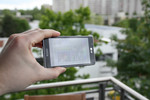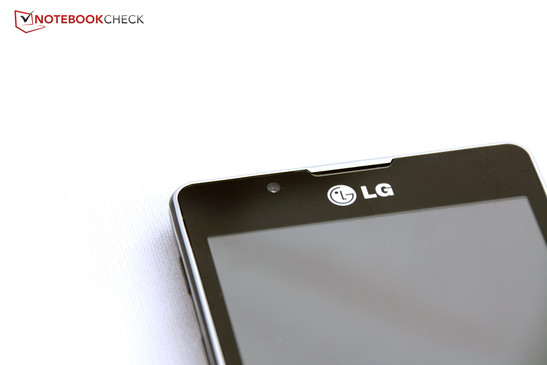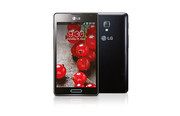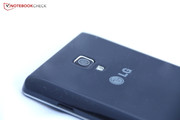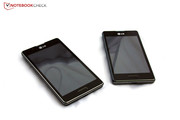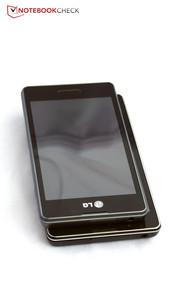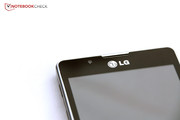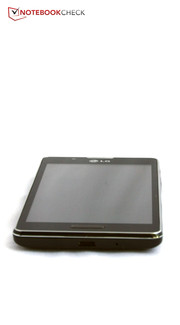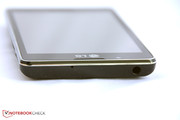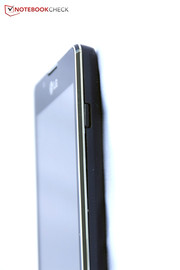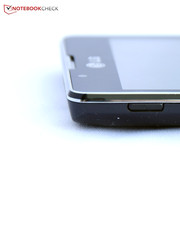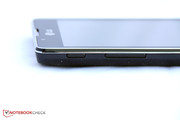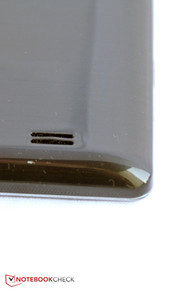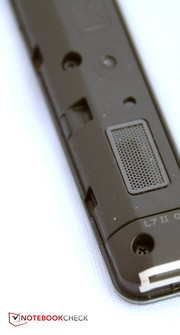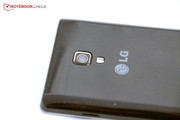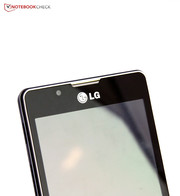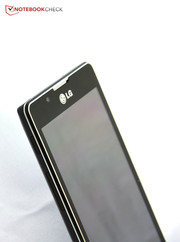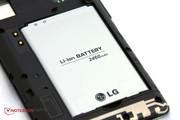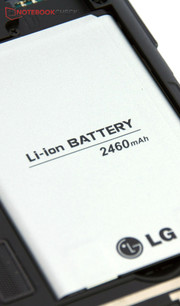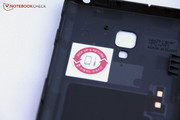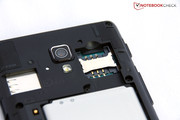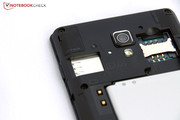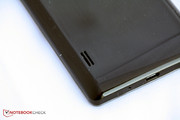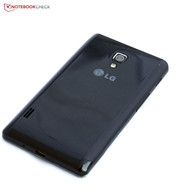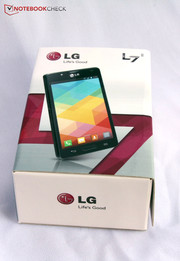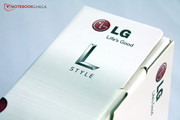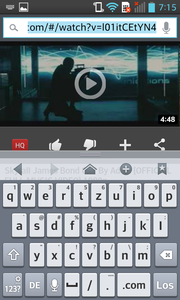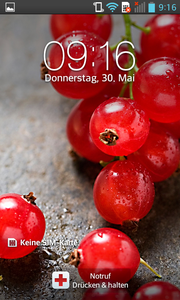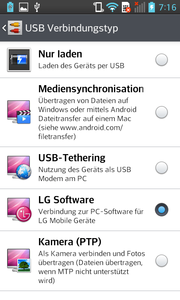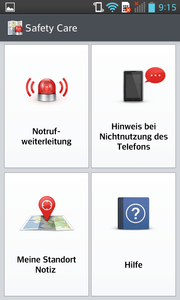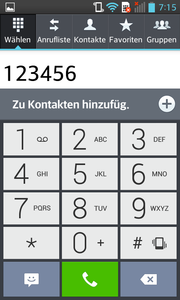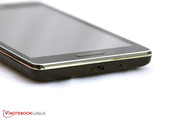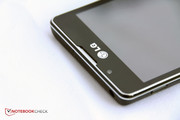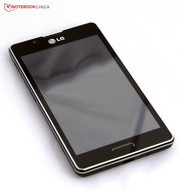Review LG P710 Optimus L7 II Smartphone

For the original German review, see here.
Currently, LG's new mid-range line-up consists of three models, the largest being the LG Optimus L7 II with its 4.3-inch screen. The predecessor (simply called LG Optimus L7) came with the same screen size, but less RAM, a lower-resolution camera and a smaller battery. In addition, the new variant now sports a dual-core processor. But with an RRP of 299 Euros (~$396), the smartphone has also reached the mid-range price segment.
There are many other great smartphones close to this price point such as the Samsung Galaxy S2 Plus, the Alcatel OneTouch Ultra, the Yarvik Ingenia X1 and the Windows Phone HTC 8S - as well as two Chinese alternatives, the ZTE Grand X IN and the Huawei Ascend G615. For a little more, even the Google Nexus 4 (16 GB model) can be had. So is LG's mid-range device able to hold its ground against these competitors?
We have already mentioned this in the review of the LG Optimus L5 II: The preceding generation of LG's mid-range smartphones was more of an eye-catcher. This time round, a rather boring and inconspicuous design language has been used. Apart from their respective (screen) sizes, the LG Optimus L7 II and its smaller sibling look almost exactly the same.
The only major difference is the color choice of their rear panels: While our Optimus L5 II test device came with a titanium-gray metal look, the Optimus L7 II we were sent sports a glossy black finish. We much prefer the former, as the latter attracts fingerprints and dirt.
The Optimus L7 II is made from nothing but plastic, however, it is well-built and very stable. We also like the light weight, coming in at just 118 grams. Out of all of its competitors, only the HTC 8S (which sports a smaller screen) manages to weigh even less.
The selection of ports is typical for smartphones: A micro USB port below and a 3.5 mm Line In/Out audio jack at the top.
The L7 II is driven by a dual-core processor, 768 MB of RAM and a disappointingly low amount of 4 GB of internal storage space. While this isn't less than what its predecessor came with, the larger operating system used in the newest generation leaves less useable room for data and apps, just 1.6 GB.
Software
Luckily, LG employs a rather recent version of Google's operating system: Android 4.1.2. Although LG did change some small details of the user interface (such as cosmetic alterations to the menu buttons), using the phone feels close to a stock Android experience. The only noticeable changes are an emergency call function in the lock screen and the Quick Memo app, which can be used as an overlay, e.g. to note down telephone numbers which can then simply be typed out again.
Communication & GPS
The LG Optimus L7 II now comes with HSUPA which is supposed to accelerate uplink connections, thus speeding up the web experience. In addition, it is equipped with Bluetooth and Near Field Communication (NFC). The Wi-Fi module is capable of handling all standards up to 802.11 n, yielding great data transfer speeds in both directions. Even 10 meters and three walls away from the FritzBox router, three out of four bars remain - decreasing to two once another two meters and a fourth wall are added.
It also ships with a GPS module for navigation, which works decently fast and well without a roof over one's head (but never finding more than five satellites, even after some waiting), yielding a typical error of around 20 meters. While not being very precise during outdoor usage, it cannot be used at all within buildings - the Samsung Galaxy S4, for example, is far better in this regard.
Phone functionality and speech quality
The phone call app sticks close to the functional standard version of Android, apart from a few cosmetic changes. Speech quality is great, as it was with its smaller sibling. Only the speaker phone is not satisfying, sounding tinny at times.
Cameras & Multimedia
The rear camera sports 8 megapixels, yielding pictures with 3264x2448 pixels. Apart from some blurring in brighter areas and some color noise (which is clearly visible when zooming in), image quality is decent and more than sufficient for snapshots and small format prints.
The front camera with its VGA resolution of just 640x480 is only suited for video calls. Its images are very blurry (as was the case with the Optimus L5) and lack finer details.
Accessories
Again, the Optimus L7 II comes very close to the L5 II, shipping with a power adapter, a USB cable and a headset. It is possible to acquire additional headsets, replacement batteries and external speakerphones on LG's website. Great: It is also possible to buy a mobile photo printer which, thanks to a special kind of pigmented paper, does not require any ink. The device costs 199 Euros (~$264) and will be available soon.
Warranty
LG offers 24 months of warranty for all its smartphones. Care has to be taken as this only holds true within the first 27 months after the device has been manufactured rendering models from older production runs a bit of a risky purchase. All accessories, such as the battery and the power adapter, come with six months of warranty.
Input Devices & Handling
Luckily, LG has removed the sticky layer on top of the touchscreen which we were so annoyed by during our test of the Optimus L5 II. Thus, it is far easier to work smoothly and comfortably with the touchscreen of the L7 II. The freely customizable button on the left hand side of the device has stayed with us, being assigned either to serve as the camera trigger or to start any application.
The virtual keyboard - while called "LG keyboard" in the settings - has remained virtually unchanged in comparison to Android's stock keyboard. This is no disadvantage, as it works intuitively and offers a special mode for the input of internet addresses. Thanks to the large 4.3-inch screen, precise input is no problem. In addition, different keyboards can easily be installed via Google's Play Store.
The LG Optimus L7 II makes use of an IPS display with a now-mediocre resolution of 480x800 pixels, the same as its predecessor, but also not less than what most competitors offer.
As with people, the largest are not always the brightest: An average value of just 244.1 cd/m² is worse than almost all of its competitors, including its smaller sibling. Only the Samsung Galaxy S2 Plus remains even fainter. Still, when compared to the smaller Optimus L5 II, the L7 II's image quality is superior thanks to its better black levels and higher contrast ratio, leading to a more vivid experience. Brightness homogeneity has been somewhat improved as well.
| |||||||||||||||||||||||||
Brightness Distribution: 88 %
Center on Battery: 258 cd/m²
Contrast: 1075:1 (Black: 0.24 cd/m²)
ΔE Color 7.37 | 0.5-29.43 Ø5
ΔE Greyscale 7.52 | 0.57-98 Ø5.3
Gamma: 2.26
As mentioned above, the Optimus L7 II offers great performance in terms of black levels (0.24 cd/m²) and contrast ratio (1075:1), beating nearly all of its competitors.
Like many other displays, the panel used in the L7 II over-exaggerates blues, as analyzed using a colorimeter and CalMAN software. Also, shades of blue deviate further from the sRGB definitions than all other colors. The grayscale isn't rendered perfectly, either.
The SoC used in the Optimus L7 II is made by Qualcomm. It comes with a 1.5 GHz Qualcomm Snapdragon S4 MSM8225 dual-core CPU and a Qualcomm Adreno 203 GPU with just one core. While the processor is capable of delivering decent performance, we are less sure about the undersized graphics card, especially during demanding tasks.
Our synthetic system and processor benchmarks quickly show that the LG Optimus L7 II is quite a bit faster than its smaller sibling, the LG Optimus L5 II. Still, it falls behind when compared to other mid-range smartphones such as the Samsung Galaxy S2 Plus or the Huawei Ascend G615 which are consistently more powerful. The system performance is decent - both the operating system and all of the apps we tested ran smoothly.
| AnTuTu v3 - Total Score (sort by value) | |
| LG P710 Optimus L7 II | |
| Samsung Galaxy S2 Plus | |
| Alcatel OneTouch Ultra 997D | |
| Huawei Ascend G615 | |
| Yarvik Ingenia X1 | |
| ZTE Grand X IN | |
| LG E460 Optimus L5 II | |
| Google Nexus 4 | |
| Geekbench 2 - 32 Bit - Total Score (sort by value) | |
| LG P710 Optimus L7 II | |
| Samsung Galaxy S2 Plus | |
| Alcatel OneTouch Ultra 997D | |
| Huawei Ascend G615 | |
| Yarvik Ingenia X1 | |
| ZTE Grand X IN | |
| LG E460 Optimus L5 II | |
| Google Nexus 4 | |
| Smartbench 2012 - Productivity Index (sort by value) | |
| LG P710 Optimus L7 II | |
| Samsung Galaxy S2 Plus | |
| Huawei Ascend G615 | |
| Yarvik Ingenia X1 | |
| ZTE Grand X IN | |
| LG E460 Optimus L5 II | |
| Google Nexus 4 | |
| Linpack Android / IOS | |
| Single Thread (sort by value) | |
| LG P710 Optimus L7 II | |
| Samsung Galaxy S2 Plus | |
| Huawei Ascend G615 | |
| ZTE Grand X IN | |
| LG E460 Optimus L5 II | |
| Google Nexus 4 | |
| Multi Thread (sort by value) | |
| LG P710 Optimus L7 II | |
| Samsung Galaxy S2 Plus | |
| Huawei Ascend G615 | |
| ZTE Grand X IN | |
| LG E460 Optimus L5 II | |
| Google Nexus 4 | |
The synthetic graphics benchmarks corroborate our fears that the feeble Qualcomm Adreno 203 might have trouble keeping pace with the other mid-range smartphones (although beating the Optimus L5 II by approximately 30%). This is especially obvious when compared to the Samsung Galaxy S2 Plus or the ZTE Grand X IN.
| AnTuTu 3DRating | |
| --- (sort by value) | |
| LG P710 Optimus L7 II | |
| Samsung Galaxy S2 Plus | |
| Huawei Ascend G615 | |
| Yarvik Ingenia X1 | |
| ZTE Grand X IN | |
| LG E460 Optimus L5 II | |
| Google Nexus 4 | |
| 1024x2048 Off-screen (sort by value) | |
| LG P710 Optimus L7 II | |
| Samsung Galaxy S2 Plus | |
| Huawei Ascend G615 | |
| Yarvik Ingenia X1 | |
| ZTE Grand X IN | |
| LG E460 Optimus L5 II | |
| Google Nexus 4 | |
| 3DMark - 1280x720 Ice Storm Standard Score (sort by value) | |
| LG P710 Optimus L7 II | |
| LG E460 Optimus L5 II | |
| Google Nexus 4 | |
| NenaMark2 - --- (sort by value) | |
| LG P710 Optimus L7 II | |
| Samsung Galaxy S2 Plus | |
| Alcatel OneTouch Ultra 997D | |
| Huawei Ascend G615 | |
| Yarvik Ingenia X1 | |
| ZTE Grand X IN | |
| LG E460 Optimus L5 II | |
| Google Nexus 4 | |
| GFXBench (DX / GLBenchmark) 2.7 | |
| T-Rex Onscreen (sort by value) | |
| LG P710 Optimus L7 II | |
| Samsung Galaxy S2 Plus | |
| Google Nexus 4 | |
| 1920x1080 T-Rex Offscreen (sort by value) | |
| LG P710 Optimus L7 II | |
| Samsung Galaxy S2 Plus | |
| Google Nexus 4 | |
| GLBenchmark 2.5 | |
| Egypt HD Fixed Time (sort by value) | |
| LG P710 Optimus L7 II | |
| Samsung Galaxy S2 Plus | |
| Huawei Ascend G615 | |
| Yarvik Ingenia X1 | |
| LG E460 Optimus L5 II | |
| Google Nexus 4 | |
| 1920x1080 Egypt HD Offscreen Fixed Time (sort by value) | |
| LG P710 Optimus L7 II | |
| Samsung Galaxy S2 Plus | |
| Huawei Ascend G615 | |
| Yarvik Ingenia X1 | |
| LG E460 Optimus L5 II | |
| Google Nexus 4 | |
| Epic Citadel | |
| High Quality (sort by value) | |
| LG P710 Optimus L7 II | |
| Samsung Galaxy S2 Plus | |
| Huawei Ascend G615 | |
| ZTE Grand X IN | |
| LG E460 Optimus L5 II | |
| Google Nexus 4 | |
| High Performance (sort by value) | |
| LG P710 Optimus L7 II | |
| Samsung Galaxy S2 Plus | |
| Alcatel OneTouch Ultra 997D | |
| Yarvik Ingenia X1 | |
| ZTE Grand X IN | |
| LG E460 Optimus L5 II | |
| Google Nexus 4 | |
| Basemark ES 2.0 - Taiji Free (sort by value) | |
| LG P710 Optimus L7 II | |
| Samsung Galaxy S2 Plus | |
| Alcatel OneTouch Ultra 997D | |
| Huawei Ascend G615 | |
| Yarvik Ingenia X1 | |
| ZTE Grand X IN | |
| LG E460 Optimus L5 II | |
| Google Nexus 4 | |
Even browsing the web is more fun with other mid-range devices. Page loading and navigation work reasonably smoothly, but other smartphones are still much faster in this regard. Only the HTC 8S fares worse than the L7 II, but this is mostly due to its software (using the slower Internet Explorer) than due to its hardware.
| Google V8 Ver. 7 - Google V8 Ver. 7 Score (sort by value) | |
| LG P710 Optimus L7 II | |
| Samsung Galaxy S2 Plus | |
| Alcatel OneTouch Ultra 997D | |
| Huawei Ascend G615 | |
| Yarvik Ingenia X1 | |
| ZTE Grand X IN | |
| LG E460 Optimus L5 II | |
| HTC Windows Phone 8S | |
| Google Nexus 4 | |
| Octane V1 - Total Score (sort by value) | |
| LG P710 Optimus L7 II | |
| Samsung Galaxy S2 Plus | |
| Huawei Ascend G615 | |
| ZTE Grand X IN | |
| LG E460 Optimus L5 II | |
| HTC Windows Phone 8S | |
| Google Nexus 4 | |
| Mozilla Kraken 1.0 - Total (sort by value) | |
| LG P710 Optimus L7 II | |
| Samsung Galaxy S2 Plus | |
| Huawei Ascend G615 | |
| ZTE Grand X IN | |
| HTC Windows Phone 8S | |
| Google Nexus 4 | |
| Sunspider - 0.9.1 Total Score (sort by value) | |
| LG P710 Optimus L7 II | |
| Samsung Galaxy S2 Plus | |
| Alcatel OneTouch Ultra 997D | |
| Huawei Ascend G615 | |
| Yarvik Ingenia X1 | |
| ZTE Grand X IN | |
| LG E460 Optimus L5 II | |
| HTC Windows Phone 8S | |
| Google Nexus 4 | |
| Peacekeeper - --- (sort by value) | |
| LG P710 Optimus L7 II | |
| Samsung Galaxy S2 Plus | |
| Alcatel OneTouch Ultra 997D | |
| Huawei Ascend G615 | |
| ZTE Grand X IN | |
| LG E460 Optimus L5 II | |
| HTC Windows Phone 8S | |
| Google Nexus 4 | |
* ... smaller is better
Demanding games such as Iron Man 3 take pretty long to load. Indeed, the 4 GB of flash memory used in the L7 II is not of the fastest kind, having to concede defeat to all of its competitors during the AndroBench benchmark.
Although LG's smartphone offers enough power for basically all applications, other manufacturers construct better products for the same amount of money. Such a future-proof investment is especially important if one plans on keeping the device for a longer stretch of time, requiring it to be able to cope well with future versions of Android too.
| AndroBench 3-5 | |
| Random Write 4KB (sort by value) | |
| LG P710 Optimus L7 II | |
| Samsung Galaxy S2 Plus | |
| Alcatel OneTouch Ultra 997D | |
| Huawei Ascend G615 | |
| Yarvik Ingenia X1 | |
| ZTE Grand X IN | |
| LG E460 Optimus L5 II | |
| Google Nexus 4 | |
| Random Read 4KB (sort by value) | |
| LG P710 Optimus L7 II | |
| Samsung Galaxy S2 Plus | |
| Alcatel OneTouch Ultra 997D | |
| Huawei Ascend G615 | |
| Yarvik Ingenia X1 | |
| ZTE Grand X IN | |
| LG E460 Optimus L5 II | |
| Google Nexus 4 | |
| Sequential Write 256KB (sort by value) | |
| LG P710 Optimus L7 II | |
| Samsung Galaxy S2 Plus | |
| Alcatel OneTouch Ultra 997D | |
| Huawei Ascend G615 | |
| Yarvik Ingenia X1 | |
| ZTE Grand X IN | |
| LG E460 Optimus L5 II | |
| Google Nexus 4 | |
| Sequential Read 256KB (sort by value) | |
| LG P710 Optimus L7 II | |
| Samsung Galaxy S2 Plus | |
| Alcatel OneTouch Ultra 997D | |
| Huawei Ascend G615 | |
| Yarvik Ingenia X1 | |
| ZTE Grand X IN | |
| LG E460 Optimus L5 II | |
| Google Nexus 4 | |
Games
It should be taken for granted that every mid-range smartphone must be capable of running 2D games such as Angry Birds: Star Wars or Vector from the Google Play Store smoothly. But what about more demanding 3D games such as Iron Man 3 and Real Racing 3? Both run reasonably well, but not as smoothly as on the Google Nexus 4. The touchscreen and position sensor controls worked reliably at all times, but we were annoyed by the long loading times due to the rather slow flash memory.
Temperature
The engineers at LG have done a great job with the LG Optimus L7 II's heat dissipation system: The case never gets uncomfortably hot, just noticeably warm with 36.1 °C under full load. 33.1 °C while being idle may be more than some of its competitors, but far away from becoming unpleasant to hold.
(+) The maximum temperature on the upper side is 36.1 °C / 97 F, compared to the average of 35 °C / 95 F, ranging from 21.9 to 56 °C for the class Smartphone.
(+) The bottom heats up to a maximum of 34.3 °C / 94 F, compared to the average of 33.8 °C / 93 F
(+) In idle usage, the average temperature for the upper side is 30.2 °C / 86 F, compared to the device average of 32.7 °C / 91 F.
Speakers
If the speaker on the rear was capable of focusing more on the lows and mids instead of solely on the highs, then it might have provided some really good audio and speech quality as it produces some loud and rich sounds. Unfortunately, it is not well-balanced at all. In addition, its sound gets dampened quickly when the smartphone is placed on soft surfaces.
Power Consumption
Energy consumption levels of the LG Optimus L7 II are mostly great, ranging from exactly 0 watts when deactivated and 0.1 watts while in standby to up to 3.6 watts under full load - which is much less than for some of its competitors. Only the consumption rate while idle is rather unfavorable, yielding up to 2.1 watts, more than all other Android-based devices. This might lead to some unfortunate consequences for its battery runtimes.
| Off / Standby | |
| Idle | |
| Load |
|
Battery Life
The battery of the LG Optimus L7 II is amply sized: Its 2460 mAh (or 9.4 Wh) is even far more than what Google offers with its Nexus 4. The LG Optimus L7 II's maximum idle consumption rate of 0.7 watts more than the Google Nexus 4 suggests that this will lead to a neck-and-neck race, especially under light load or while idle. Indeed, the Google Nexus 4 manages to beat the L7 II by half an hour during our realistic Wi-Fi test - despite its smaller battery and its more powerful internal components. Under full load, the LG Optimus L7 II is finally capable of displaying its strengths, showing some great endurance: It takes more than four hours until its battery finally runs dry.
Verdict
As was the case with the LG Optimus L5 II, the Optimus L7 II remains rather unremarkable, sporting neither obvious highlights nor glaring weaknesses. This may be a problem for the L7 II since there are already a lot of other great devices on the highly competitive smartphone market.
There are some advantages to LG's new mid-range phone. It is a very functional device capable of running almost all apps smoothly. Build quality is decent, as is the image quality of the rear camera (8 megapixels). The touchscreen works well and the lightweight design also speaks in its favor.
Unfortunately, its surfaces are very susceptible to dirt and its display - while offering good black levels and viewing angles - disappoints due to its low maximum brightness. When compared to its equally-prized competitors, the L7 II lacks some performance as well as suitable speakers.
Those who are looking for an unpretentious smartphone with solid mid-range specs in all relevant areas can't go wrong with the LG Optimus L7 II. Still, other manufacturers offer more bang for the buck - no matter whether we are talking about better performance or a brighter screen. For just 50 Euros (~$66) more, a Google Nexus 4 can be had which offers one of the best cost-benefit ratios on the market. LG should have put some more effort into its new device in order to fully convince potential customers of its merits.


 Deutsch
Deutsch English
English Español
Español Français
Français Italiano
Italiano Nederlands
Nederlands Polski
Polski Português
Português Русский
Русский Türkçe
Türkçe Svenska
Svenska Chinese
Chinese Magyar
Magyar
















